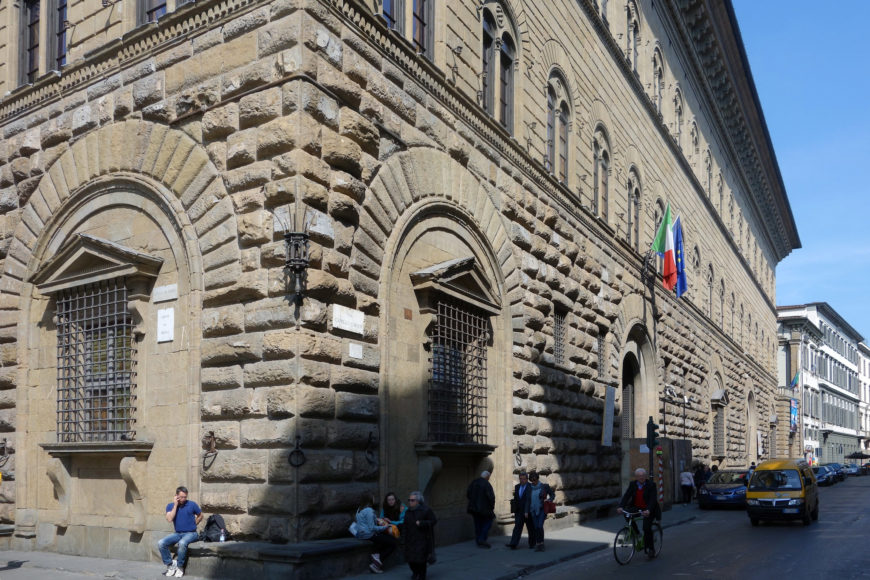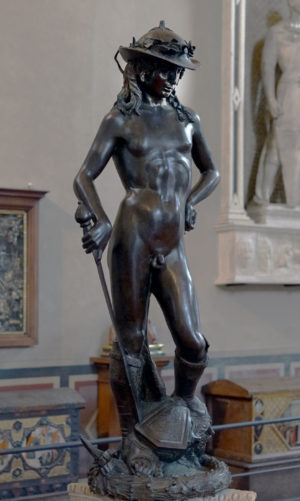Donatello, David, bronze, late 1420s to the 1460s, likely the 1440s (Museo Nazionale del Bargello, Florence); speakers: Dr. Beth Harris and Dr. Steven Zucker
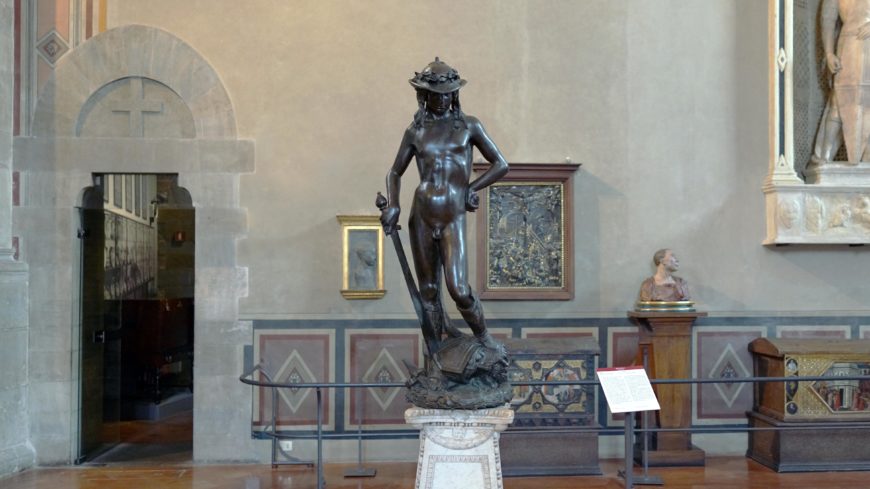
Donatello, David, c. 1440, bronze, 158 cm (Museo Nazionale de Bargello, Florence; photo: Steven Zucker, CC BY-NC-SA 2.0)
Between 1445 and the mid-1450s, Cosimo de’Medici, the most powerful man in Florence, built his family’s palace on a central thoroughfare in the heart of the city. A savvy patron, Cosimo was aware that the appearance of this formidable building, designed by Michelozzo, would reflect upon his family. Although technically private citizens of a republic, in reality, the Medici clan dominated the city’s politics, a fact they shrewdly endeavored to obscure. The architecture projected an image of strength and refinement while drawing calculated associations with the city’s republican government through the rusticated stone of the lowest story mimicking that of the Palazzi dei Priori also known as the Palazzo Vecchio (the town hall). For a public figure like Cosimo, a private house was never private in our modern sense: the Palazzo Medici was a place of business (Cosimo was a banker and de facto ruler of Florence) and bustling social interactions with an open courtyard, visible from the street, leading to the main entrance. High upon an elevated base and visible when the main entry to the palace was open to visitors stood one of the most innovative sculptures of the early renaissance: Donatello’s bronze David.
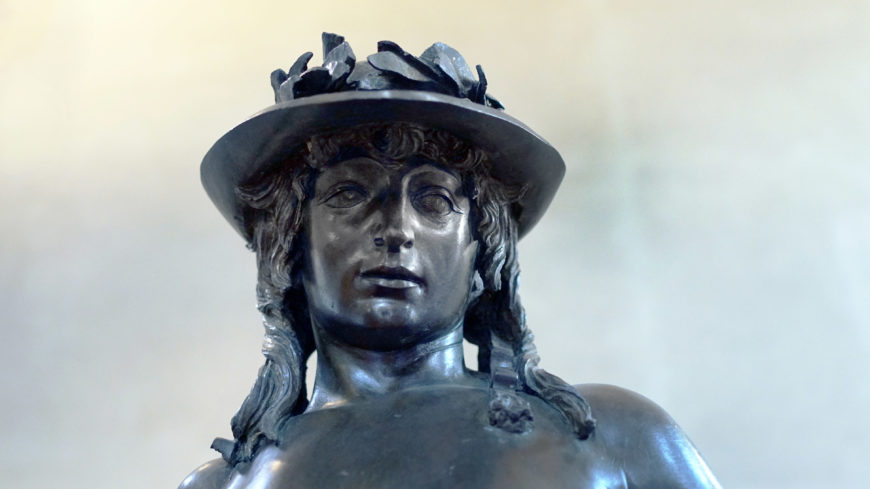
Donatello, David, c. 1440, bronze, 158 cm (Museo Nazionale de Bargello, Florence; photo: Steven Zucker, CC BY-NC-SA 2.0)
Donatello’s hero is remarkable for numerous reasons, not least of which is the sculpture’s all’antica (“in the manner of the antique”) form. In some ways the work epitomizes new trends in early renaissance art: it is the earliest known freestanding nude sculpture since antiquity. Furthermore, it is cast in bronze, a costly medium not generally used for large-scale freestanding sculpture in the medieval era—it would take a Medici to afford such an expense. Although it is a difficult sculpture to date, it was probably finished by the early 1450s. [1] And while no documentation survives for the commission, primary sources confirm that it was displayed in the Medici courtyard by 1469 and was thus likely a Medici commission from the start.
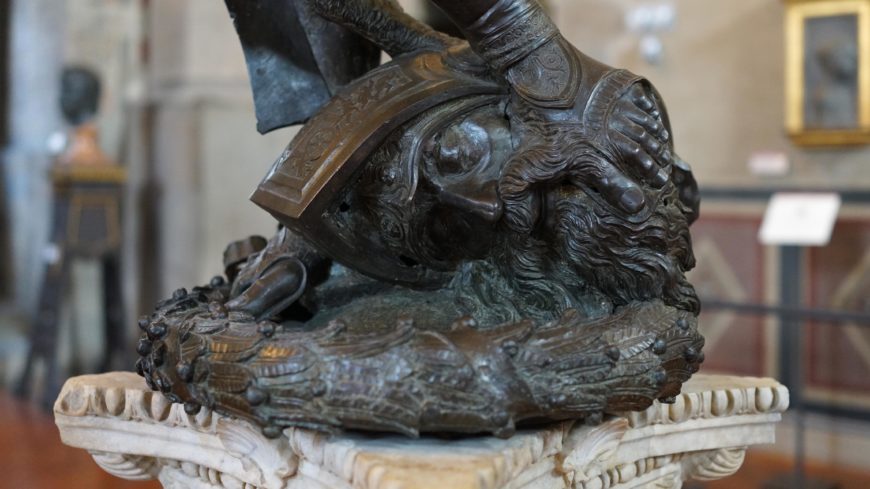
Goliath’s severed head (detail), Donatello, David, c. 1440, bronze, 158 cm (Museo Nazionale de Bargello, Florence; photo: Steven Zucker, CC BY-NC-SA 2.0)
Who’s the naked guy?
The subject of this statue is David, the future king and hero of the Hebrew Bible, who as a youth slayed the giant Goliath and liberated his people (the Israelites) from the tyranny of the Philistines. In Donatello’s sculpture, David’s immaturity is unquestionable: his nude body is that of an adolescent and is sharply contrasted with the heavy beard and maturity of Goliath, whose severed head is at his feet. David’s vulnerability is emphasized by the stone he clasps in his left hand, a reminder that though he holds a sword, he brought down his massive foe with a simple sling-shot. The message here is clear: David triumphed not through physical power, but through the grace of God.
While the biblical account (1 Samuel 17) does note that David chose not to face Goliath wearing the armor offered to him by his father, nowhere does it state that he removed his clothes completely. In all earlier images of David, including an earlier marble version carved by Donatello himself, David is clothed. The choice to depict David as completely nude, except for a shepherd’s hat adorned with laurels of victory and elaborate sandals, was unprecedented.

Spinario, c. 1st century B.C.E., bronze, 73 cm high (Musei Capitolini, Rome; photo: Steven Zucker, CC BY-NC-SA 2.0)
So . . . why is he naked?
David’s nudity serves several functions. Exposing his youthful (weak) body overtly reinforces the miraculous nature of his triumph. David is literally bared before God and the viewing public, victorious through God’s will alone. Standing in contrapposto and displaying accurate anatomy, the sculpture also demonstrates the growing interest in humanism, an intellectual movement that looked to the Greco-Roman past for inspiration.
Donatello’s nude is reminiscent of ancient Greek and Roman statues, like the youthful Spinario. This ancient bronze sculpture at the Lateran Palace in Rome had already inspired Donatello’s contemporaries, Filippo Brunelleschi and Lorenzo Ghiberti who both riffed upon the figure in their respective bronze panels displaying the Sacrifice of Isaac created for the competition of the Florentine baptistery doors.
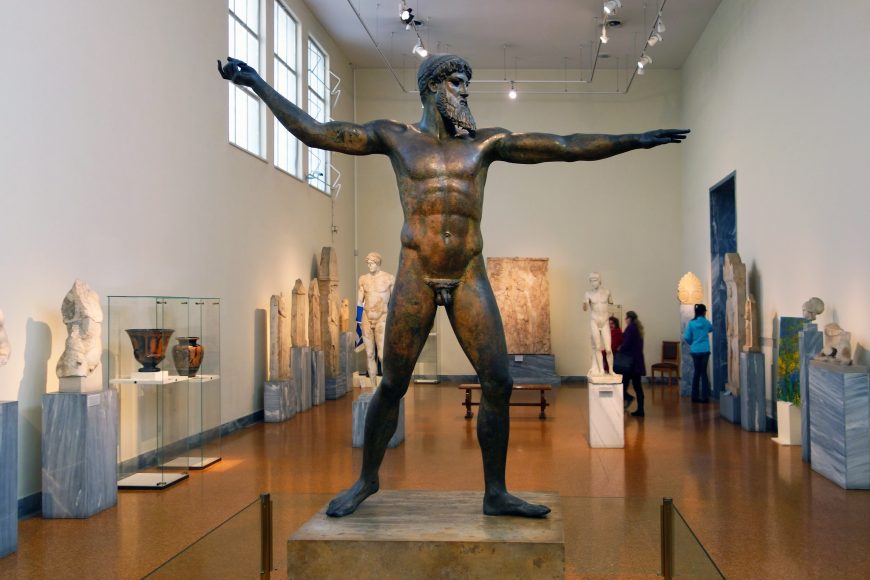
Artemision Zeus or Poseidon, c. 460 B.C.E., bronze, 2.09 m high, Early Classical (Severe Style), recovered from a shipwreck off Cape Artemision, Greece in 1928 (National Archaeological Museum, Athens, (photo: Steven Zucker, CC BY-NC-SA 2.0)
In ancient art being shown without clothing often had positive connotations: ancient Greek and Roman gods and heroes signaled their virtue through their idealized nude bodies. By showing David in the nude, Donatello appropriates this convention. From the point of view of renaissance Christians, David’s nudity would have been seen as an improvement upon the ancient tradition, heroizing a Judeo-Christian subject rather than a pagan one.
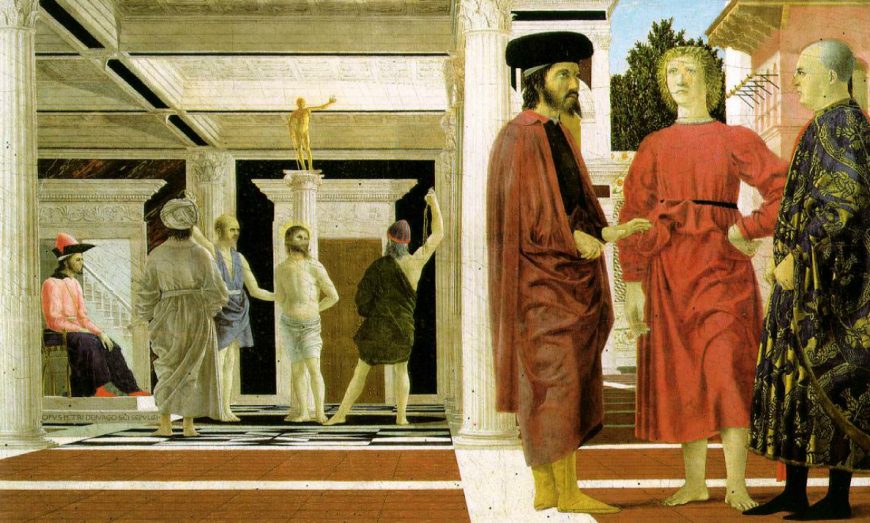
Piero della Francesca, Flagellation of Christ, c. 1455–65, oil and tempera on wood, 58.4 × 81.5 cm (Galleria Nazionale delle Marche, Urbino)
This points to another key aspect of the work: its original placement upon an elevated column. This reflects a medieval practice of representing pagan cults using the motif of a nude figure—what renaissance audiences would have viewed as an “idol”—upon a column. We see this represented, for example, in Piero della Francesca’s fresco, the Flagellation of Christ, where the Christian savior is tortured while tied to a column topped with a nude “ancient” statue. Placing the biblical hero David in this position may have communicated the triumph of Christianity over pagan Antiquity, making the sculpture both fashionably all’antica and appropriately Christian.
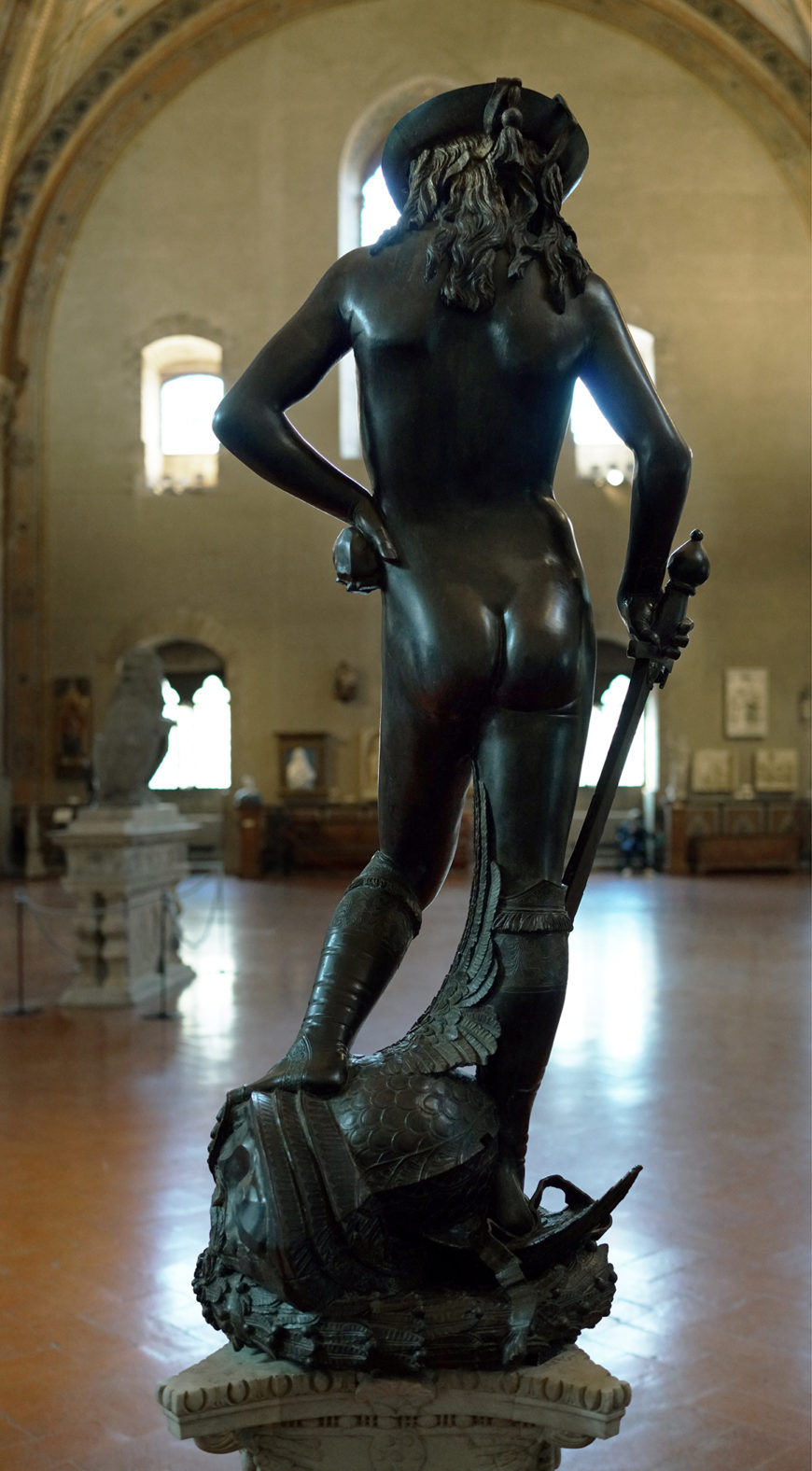
Donatello, David, c. 1440, bronze, 158 cm (Museo Nazionale de Bargello, Florence (photo: Steven Zucker, CC BY-NC-SA 2.0)
But . . . isn’t he a little too sexy?
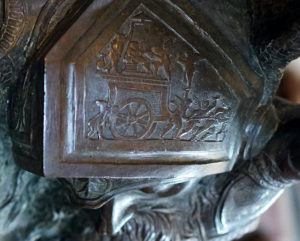
Chariot of Eros on Goliath’s Helmet (detail), Donatello, David, c. 1440, bronze, 158 cm (Museo Nazionale de Bargello, Florence) (photo: Steven Zucker, CC BY-NC-SA 2.0)
When seen from behind, the sex of Donatello’s David is ambiguous. In this patriarchal world, this androgyny may have been yet another reminder of his ineptness for battle. Renaissance Italy was male dominated: power passed from father to son and both religious and secular authorities insisted upon the superiority of men and masculinity. The sexual ambiguity, even effeminacy, of Donatello’s David helps emphasize that the youth’s victory could only be achieved by God’s intervention. When viewed from up close—an experience likely only available to privileged visitors to the palazzo—this androgynous nudity is further complicated by erotic undertones. Goliath’s helmet is adorned by a scene of Eros (Love) riding a chariot and a feather delicately caresses David’s inner thigh, both elements suggest themes of erotic love.
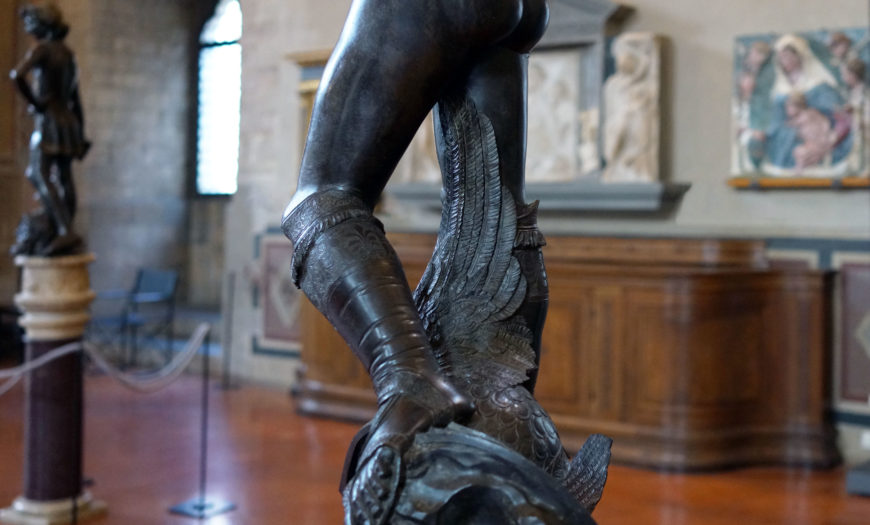
Feather (detail), Donatello, David, c. 1440, bronze, 158 cm (Museo Nazionale de Bargello, Florence) (photo: Steven Zucker, CC BY-NC-SA 2.0)
Scholars have tied this eroticism to Florentine obsession with youthful male beauty, an interest that is evidenced in numerous works of art and even brought the ire of Florentine preachers who called it a sinful perversion. The fact that the sword, hat, and sandals are of contemporary Florentine fashion and not that of biblical times, suggests a connection to these renaissance preoccupations. Of course, David’s beauty, his desirability, was also part of the biblical tradition. He is referred to as “most beautiful among the sons of men” in Psalm 44 and the name “David” was translated to mean “beloved.” The message would have been clear to renaissance Florentines: Donatello’s David embodies desirability, he is beloved by God and this is the source of his victory.
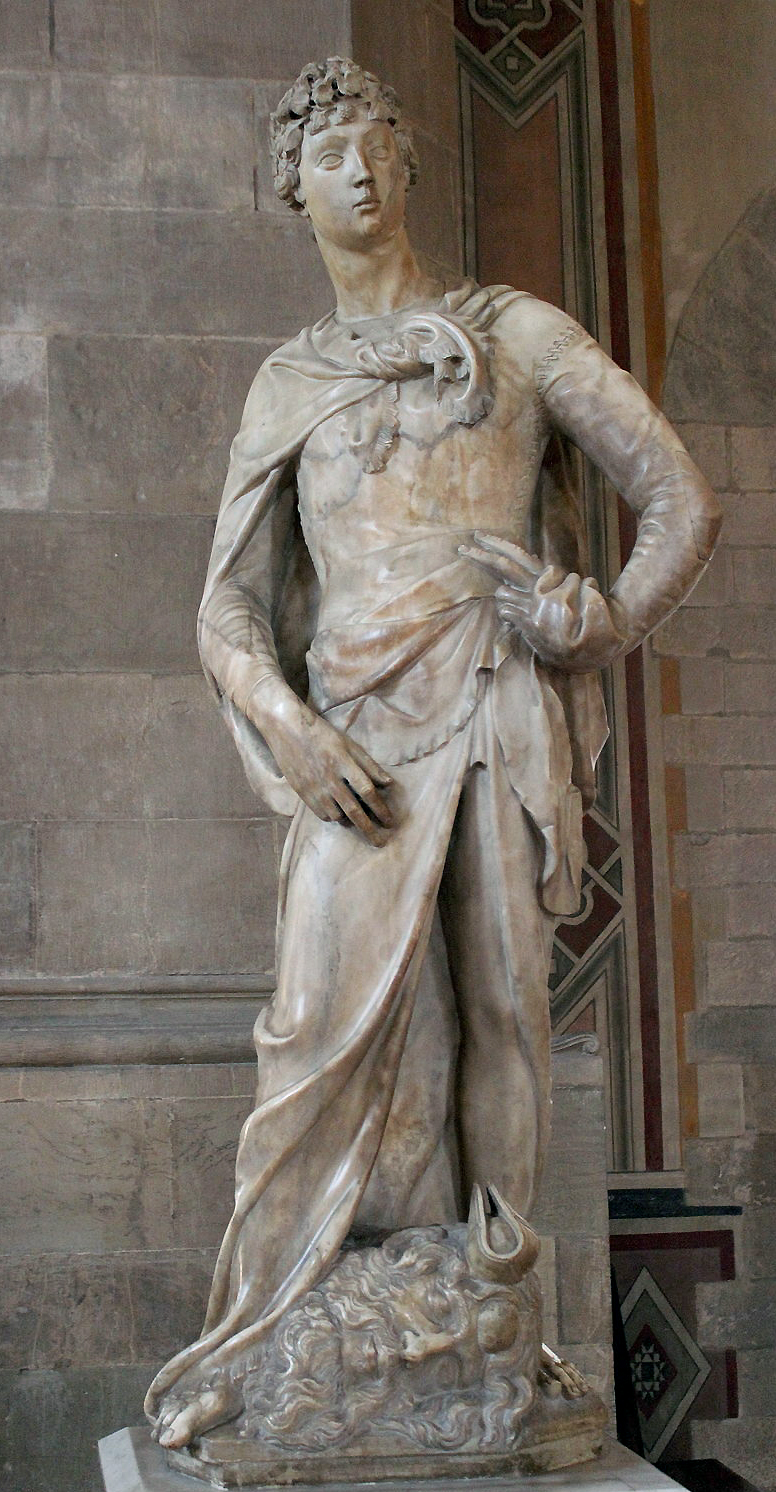
Donatello, David, 1408–09, marble, 191 x 57.5 cm (Museo Nazionale de Bargello, Florence; photo: Miguel Hermoso Cuesta, CC BY-SA 4.0)
Symbol of Florence, symbol of the Medici (or “let’s pretend we’re not really tyrants”)
By the time the bronze David was created, the hero was already a symbol of the Florentine Republic. Donatello’s marble David had been on display in front of the Palazzo dei Priori since 1416 against a backdrop of lilies, an insignia of Florence. By placing this civic hero in their private courtyard, the Medici claimed for themselves this state symbol, making David a Medici emblem as well as a Florentine one.
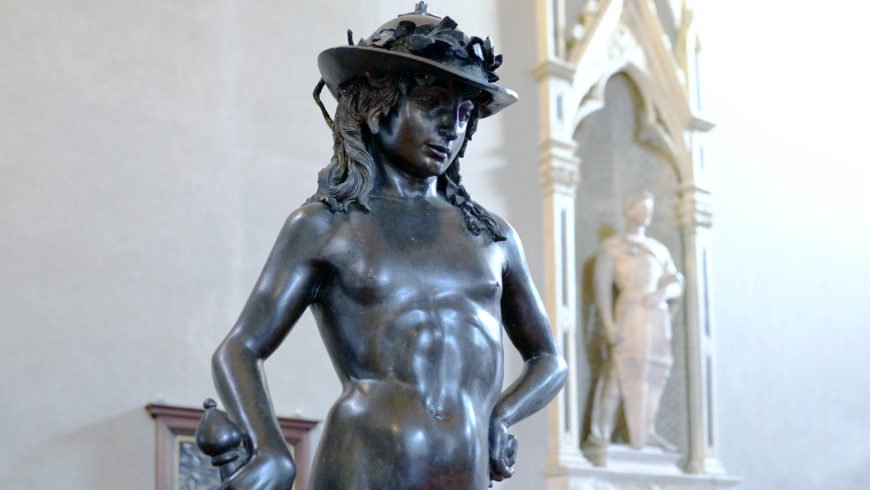
Donatello, David, c. 1440, bronze, 158 cm (Museo Nazionale de Bargello, Florence; photo: Steven Zucker, CC BY-NC-SA 2.0)
For a family of supposedly private citizens of a republican state who were all but absolute rulers in practice, the Medici had good reason to associate themselves with David’s anti-tyrannical symbolism. Cosimo and his family likely wanted all visitors to their palace to regard them—like David—as defenders of liberty. This reading is reinforced by an inscription (now lost) that once adorned the column at the statue’s base:
The Victor is whoever defends the fatherland! God crushes the wrath of an enormous foe. Behold! A boy overcame a great tyrant. Conquer, O citizens!
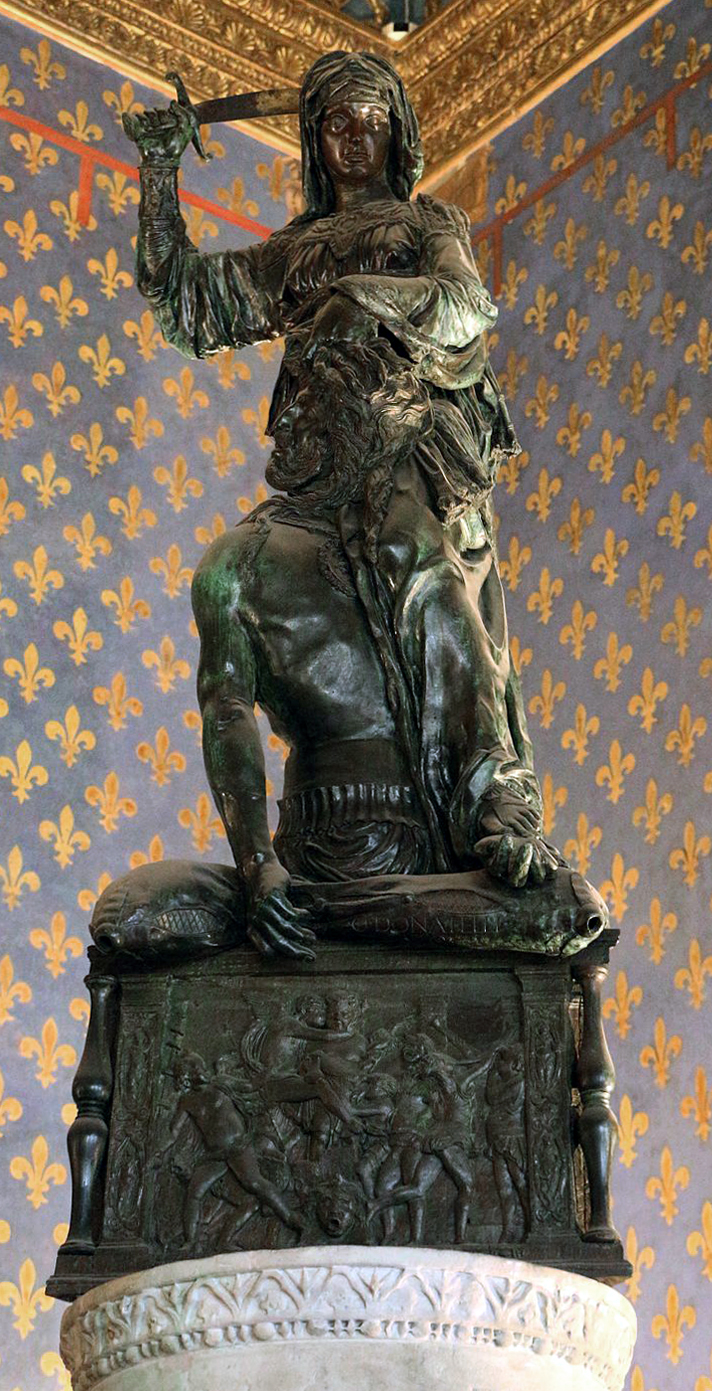
Donatello, Judith and Holofernes, bronze, c. 1455, Palazzo Vecchio, Florence (photo: Sailko, CC BY 3.0)
Another work by Donatello displayed nearby in the palazzo also supports this message. In the garden adjacent to the courtyard where the bronze David was displayed was the artist’s bronze Judith and Holofernes. Judith was understood to be an exemplar of virtue; like David she was a heroine of the Hebrew Bible who slayed an enemy leader and thus liberated her people. It is likely that Judith and Holofernes was intended as a pendant with the bronze David, the pair working together to visually reinforce the Medici family as defenders of Florentine liberty.
David for the win
Donatello’s costly life-sized bronze is often eclipsed in the modern imagination by Michelangelo’s better known marble version. The later artist’s nude colossus, however, owes much to the early renaissance sculptor. An intimate work in a semi-public setting, Donatello gives us a hero for the ages: a youth who does the implausible and therefore achieves the miraculous.
Notes:
[1] Scholars have argued for a range of dates for the David, some placing its creation as early as 1428-30 and others as late as 1460. It is generally thought that the David was probably commissioned by Cosimo de’Medici after his return from exile in 1434.
Additional resources:
Francis Ames-Lewis, “Donatello’s Bronze David and the Palazzo Medici Courtyard,” Renaissance Studies 3.3 (1989), pp. 235–51.
Sarah Blake McHam, “Donatello’s Bronze “David” and “Judith” as Metaphors of Medici Rule in Florence,” The Art Bulletin 83, no. 1 (2001), pp. 32–47.
Roger J. Crum, “Donatello’s Bronze “David” and the Question of Foreign versus Domestic Tyranny,” Renaissance Studies 10, no. 4 (1996), pp. 440–50.
Christopher Fulton, “The Boy Stripped Bare by His Elders: Art and Adolescence in Renaissance Florence,” Art Journal 56, no. 2 (1997), pp. 31–40.
Rab Hatfield, “Some Unknown Descriptions of the Medici Palace in 1459,” Art Bulletin 52.3 (1970), pp. 232–49.
W. Janson, The Sculpture of Donatello. Princeton: Princeton University Press, 1963. First published 1957.
Ronald Lightbown, Donatello and Michelozzo: An Artistic Partnership and Its Patrons in the Early Renaissance. 2 vols. (London: Harvey Miller, 1980).
Matthew G. Looper, “Political Messages in the Medici Palace Garden,” Journal of Garden History 12 (1992), pp. 255–68.
Joachim Poeschke, Donatello and His World: Sculpture of the Italian Renaissance. New York: H. N. Abrams, 1993.
Christine M. Sperling, “Donatello’s Bronze ‘David” and the Demands of Medici Politics,” The Burlington Magazine 134, no. 1069 (1992), pp. 218–24.
Allie Terry-Fritsch, “Embodied Temporality: Lucrezia Tornabuoni de’ Medici’s sacra storia, Donatello’s Judith, and the Performance of Gendered Authority in Palazzo Medici, Florence,” in Wiesner-Hanks M., ed., Gendered Temporalities in the Early Modern World (2008), pp. 187–212.
Allie Terry-Fritsch, “Donatello’s Decapitations and the Rhetoric of Beheading in Renaissance Florence,” Renaissance Studies 23.5 (2009), pp. 609–638.
Smarthistory images for teaching and learning:
[flickr_tags user_id=”82032880@N00″ tags=”DonatelloDavid,”]

